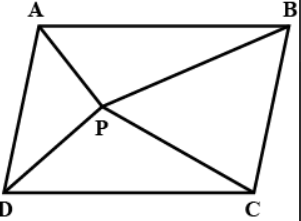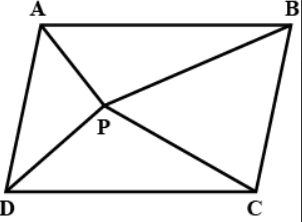কখন কোন সেট A-এর ওপর সংজ্ঞাত একটি সম্বন্ধ স্বসম নয়?মনে কর, A={a,b,c,d} এবং A-র ওপর একটি সম্বন্ধ হল R, যেখানে R={(a,a),(a,c),(c,a),(c,c),(d,d)}, Aওপর R কি স্বসম?
Step by step video & image solution for কখন কোন সেট A-এর ওপর সংজ্ঞাত একটি সম্বন্ধ স্বসম নয়?মনে কর, A = {a, b, c, d} এবং A-র ওপর একটি সম্বন্ধ হল R, যেখানে R = {(a, a), (a, c), (c, a), (c, c), (d, d)}, Aওপর R কি স্বসম? by Maths experts to help you in doubts & scoring excellent marks in Class 12 exams.
Updated on:21/07/2023Topper's Solved these Questions
Similar Questions
A={1,2,3,4} এবং A-সেটের ওপর একক সম্বন্ধ Iᴀ হলে-
View Solution∫sec6xdx সমাকলন নির্ণয় করতে হলে বসাতে হবে -
View SolutionIn Figure, P is a point in the interior of a parallelogram ABCD . Show that ar(APB)+ar(PCD)=12ar(^(gm)ABCD) aR(APD)+ar(PBC)=ar(APB)+ar(PCD)

View SolutionIn Figure, P is a point in the interior of a parallelogram ABCD. Show that ar(APB)+ar(PCD)=12ar (||gmABCD) ar (APD)+ar (PBC)=ar (APB)+ar(PCD)

View SolutionIf ABCD is a parallelogram, then prove that ar(△ABD)=ar(△BCD)=ar(△ABC)=ar(△ACD)=12ar(∣∣gmABCD)
View SolutionABCD IS A PARALLELOGRAM AND O is any point in its interior. Prove that: ar (AOB)+ ar (COD)= ar (BOC)+ ar(AOD) ar (AOB)+ar (COD)=12 ar(^(gm)ABCD) Given: A parallelogram ABCD and O is a point in its interior. To Prove: ar ( AOB)+ ar(COD)=ar (BOC)+ar(AOD)
View SolutionState whether the statement is true or false ?
If A={a,b,c,d}andR={(a,c),(b,d),(b,c),(c,a),(d,b)} then R is a symmertric relation on A .
View Solutionস্বাভাবিক সংখ্যাসমূহের সেট Nএর ওপর একটি সম্বন্ধ R নিম্নরূপে সংজ্ঞাত হয়:(x,y)∈R⇒x−y+√3একটি অমূলদ সংখ্যা, সব x,y=∈N এর জন্য। দেখাও যে,NএরওপরRR সম্বন্ধ স্বসম।
View Solutionমনে কর, স্বাভাবিক সংখ্যা সমূহের সেট N -এর ওপর একটি সম্বন্ধ R-এর সংজ্ঞা এইরূপ :nRm
View Solutionমনে করো xy সমতলে অবস্থিত S একটি বৃত্ত, যা x2+y2 = 4 সমীকরণ দ্বারা সংজ্ঞাত। মনে করো S বৃত্তের ওপর P এমন একটি বিন্দু যার স্থানাঙ্ক দুটি (x স্থানাঙ্ক ও yস্থানাঙ্ক) ধনাত্মক। মনে করো P বিন্দুতে S বৃত্তের স্পর্শক অক্ষদ্বয়কে M ও N বিন্দুতে ছেদ করেছে। তবে MN সরলরেখার মধ্যবিন্দু যে বক্রের ওপর অবস্থিত, তা হল—
View SolutionLet A = {a,b,c,d} and R = {(a,b),(a,c),(a,d), (b,c), (b,d), (c,d)} then R =R is equal to
View SolutionIf ABCD is a parallelogram, the prove that ar(ABD)=ar(BCD)=ar(ABC)=ar(ACD)=1/2a r(∣∣gmA B C D)
View SolutionIn Figure, P is a point in the interior of a parallelogram ABCD . Show that ar(APB)+ar(PCD)=12ar(^(gm)ABCD) aR(APD)+ar(PBC)=ar(APB)+ar(PCD)
View SolutionIn Figure, △ABC and △DBC are on the same base BC . If AD and BC intersect at O , prove that Area (ABC)Area (DBC)=AODO.
View SolutionIn ABC , AD and BE are altitudes. Prove that ar(DEC)ar(ABC)=DC2AC2
View SolutionIn Figure, P is a point in the interior of a parallelogram ABCD. Show that ar(APB)+ar(PCD)=12ar (||gmABCD) ar (APD)+ar (PBC)=ar (APB)+ar(PCD)
View Solution